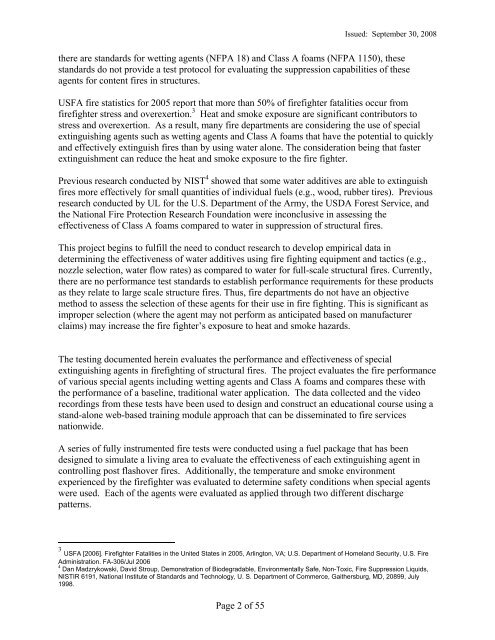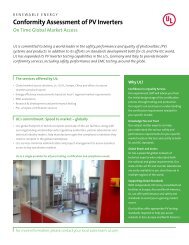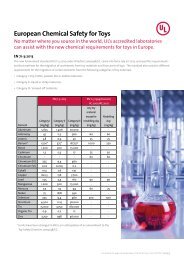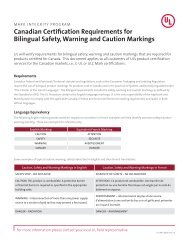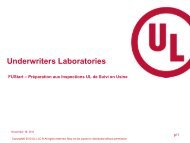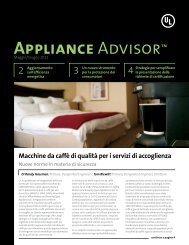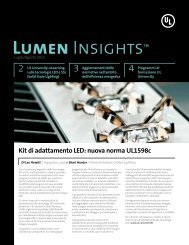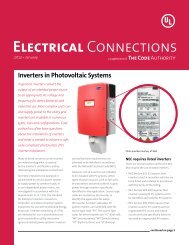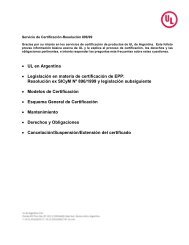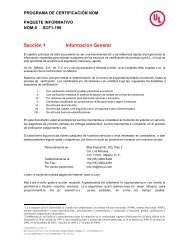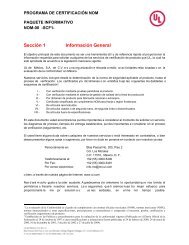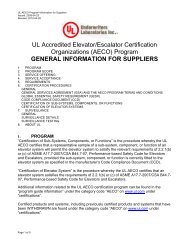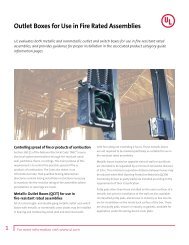Performance of Special Extinguishment Agents for ... - UL.com
Performance of Special Extinguishment Agents for ... - UL.com
Performance of Special Extinguishment Agents for ... - UL.com
You also want an ePaper? Increase the reach of your titles
YUMPU automatically turns print PDFs into web optimized ePapers that Google loves.
Issued: September 30, 2008<br />
there are standards <strong>for</strong> wetting agents (NFPA 18) and Class A foams (NFPA 1150), these<br />
standards do not provide a test protocol <strong>for</strong> evaluating the suppression capabilities <strong>of</strong> these<br />
agents <strong>for</strong> content fires in structures.<br />
USFA fire statistics <strong>for</strong> 2005 report that more than 50% <strong>of</strong> firefighter fatalities occur from<br />
firefighter stress and overexertion. 3 Heat and smoke exposure are significant contributors to<br />
stress and overexertion. As a result, many fire departments are considering the use <strong>of</strong> special<br />
extinguishing agents such as wetting agents and Class A foams that have the potential to quickly<br />
and effectively extinguish fires than by using water alone. The consideration being that faster<br />
extinguishment can reduce the heat and smoke exposure to the fire fighter.<br />
Previous research conducted by NIST 4 showed that some water additives are able to extinguish<br />
fires more effectively <strong>for</strong> small quantities <strong>of</strong> individual fuels (e.g., wood, rubber tires). Previous<br />
research conducted by <strong>UL</strong> <strong>for</strong> the U.S. Department <strong>of</strong> the Army, the USDA Forest Service, and<br />
the National Fire Protection Research Foundation were inconclusive in assessing the<br />
effectiveness <strong>of</strong> Class A foams <strong>com</strong>pared to water in suppression <strong>of</strong> structural fires.<br />
This project begins to fulfill the need to conduct research to develop empirical data in<br />
determining the effectiveness <strong>of</strong> water additives using fire fighting equipment and tactics (e.g.,<br />
nozzle selection, water flow rates) as <strong>com</strong>pared to water <strong>for</strong> full-scale structural fires. Currently,<br />
there are no per<strong>for</strong>mance test standards to establish per<strong>for</strong>mance requirements <strong>for</strong> these products<br />
as they relate to large scale structure fires. Thus, fire departments do not have an objective<br />
method to assess the selection <strong>of</strong> these agents <strong>for</strong> their use in fire fighting. This is significant as<br />
improper selection (where the agent may not per<strong>for</strong>m as anticipated based on manufacturer<br />
claims) may increase the fire fighter’s exposure to heat and smoke hazards.<br />
The testing documented herein evaluates the per<strong>for</strong>mance and effectiveness <strong>of</strong> special<br />
extinguishing agents in firefighting <strong>of</strong> structural fires. The project evaluates the fire per<strong>for</strong>mance<br />
<strong>of</strong> various special agents including wetting agents and Class A foams and <strong>com</strong>pares these with<br />
the per<strong>for</strong>mance <strong>of</strong> a baseline, traditional water application. The data collected and the video<br />
recordings from these tests have been used to design and construct an educational course using a<br />
stand-alone web-based training module approach that can be disseminated to fire services<br />
nationwide.<br />
A series <strong>of</strong> fully instrumented fire tests were conducted using a fuel package that has been<br />
designed to simulate a living area to evaluate the effectiveness <strong>of</strong> each extinguishing agent in<br />
controlling post flashover fires. Additionally, the temperature and smoke environment<br />
experienced by the firefighter was evaluated to determine safety conditions when special agents<br />
were used. Each <strong>of</strong> the agents were evaluated as applied through two different discharge<br />
patterns.<br />
3 USFA [2006]. Firefighter Fatalities in the United States in 2005, Arlington, VA; U.S. Department <strong>of</strong> Homeland Security, U.S. Fire<br />
Administration. FA-306/Jul 2006<br />
4<br />
Dan Madzrykowski, David Stroup, Demonstration <strong>of</strong> Biodegradable, Environmentally Safe, Non-Toxic, Fire Suppression Liquids,<br />
NISTIR 6191, National Institute <strong>of</strong> Standards and Technology, U. S. Department <strong>of</strong> Commerce, Gaithersburg, MD, 20899, July<br />
1998.<br />
Page 2 <strong>of</strong> 55


